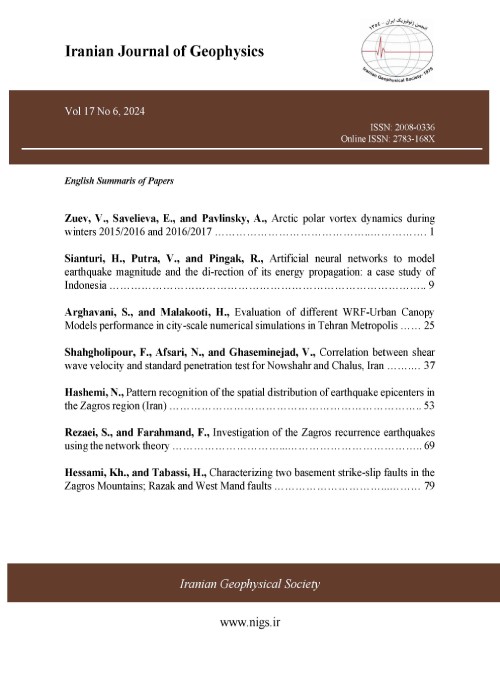Identifying causative fault of 11th May 2013 Goharan Earthquake using relocation of aftershocks and focal mechanisms
Author(s):
Abstract:
On the 11thMay 2013 at 2:08:08 GMT, a moderate earthquake (Mw=6.2) occurred in Hormozgan province, near the Goharan village (southeast Iran). The largest aftershock of magnitude 5.8 occurred on 12th May 2013 at 12:07:02 GMT near the mainshock, which produced more destruction. According to the reports, one person died and 17 people injured. This earthquake is the first noticeable recorded event in this area. By this time,the most important seismic activity had occurred in 1983 with magnitude Ms=5.7 (ISC). Aftershock sequences provide valuable information about the Earthâs crust and source properties of large earthquakes. This is because a large number of events occur during a short time in a small area. This earthquake had a lot of aftershocks, after 3 months Iranian seismological center (IRSC) recorded 284 events.    Generally, initial location of earthquakes produce inevitable error because of algorithms we use to locate earthquakes. But this error will be decreased by relocating. One of the most common methods used is double-difference algorithm developed by Felix Waldhauser (2000). The double-difference is one of the relative earthquake location methods in these methods, effects of errors produced by deviation from real structure velocity model can also be minimized. According to the theory of double-difference, if the hypocentral separation between two earthquakes is small (compared to the event station distance and the scale length of the velocity heterogeneity), then the ray paths between the two sources and a common station are similar along the entire ray path. In this case, the difference in travel times for two events observed at one station can be related to the spatial offset between the events with high accuracy.    Previous studies have shown that the direction of causative fault (related to mainshock) can be obtained by the distribution of aftershocks, but it does not exactly assess motion on the fault occurred during the earthquake. So obtaining focal mechanism of the mainshock and largest aftershocks could help us to solve this important problaluablem. There are some methods to obtain focal mechanism and one of the most powerful methods is moment tensor inversion. This method has developed for a local earthquake by Zahradnik et al (2005). This algorithm has been written in Fortran language programing named ISOLA. The ISOLA GUI has been created using the Matlab GUIDE tool.ISOLA is based on multiple point-source representation and iterative deconvolution method, similar to what Kikuchi and Kanamori (1991) have done for teleseismic records, but here the full wavefield is considered, and Green's functions are calculated by the discrete wavenumber method of Bouchon (1981). Thus, the method is applicable to regional and local events.   In this study, we use double-difference algorithm to relocate the mainshock and aftershocks of this earthquake. During this process, the error of location improved (compare to initial location). By using spatial-temporal analyse of aftershock sequence we derived that the causative fault of this earthquake is in an east-west direction. All the aftershocks are distributed in the area with length 40 km and width 25 km, but the most of them are being in a cluster with length 15 km and width 10 km. We determined the focal mechanisms of this earthquake, and 15 other large aftershocks by moment tensor inversion method (Isola software) and the results show that all of the events have a predominatinely strike-slip mechanism. According to the distribution of the aftershocks we determined, fault plane is distinguished from the nodal plane. The fault plane is a left-lateral strike-slip in the SW-NE direction. According to the Geological evidence, this earthquake is related to the unknown fault in this region, but topographic map shows that probably this earthquake is related to linear structure parallel to aftershocks distribution and the fault plane that obtained in this study using CMT(Centroid Moment Tensor) method.
Keywords:
Language:
Persian
Published:
Iranian Journal of Geophysics, Volume:9 Issue: 4, 2016
Pages:
54 to 67
magiran.com/p1518229
دانلود و مطالعه متن این مقاله با یکی از روشهای زیر امکان پذیر است:
اشتراک شخصی
با عضویت و پرداخت آنلاین حق اشتراک یکساله به مبلغ 1,390,000ريال میتوانید 70 عنوان مطلب دانلود کنید!
اشتراک سازمانی
به کتابخانه دانشگاه یا محل کار خود پیشنهاد کنید تا اشتراک سازمانی این پایگاه را برای دسترسی نامحدود همه کاربران به متن مطالب تهیه نمایند!
توجه!
- حق عضویت دریافتی صرف حمایت از نشریات عضو و نگهداری، تکمیل و توسعه مگیران میشود.
- پرداخت حق اشتراک و دانلود مقالات اجازه بازنشر آن در سایر رسانههای چاپی و دیجیتال را به کاربر نمیدهد.
In order to view content subscription is required
Personal subscription
Subscribe magiran.com for 70 € euros via PayPal and download 70 articles during a year.
Organization subscription
Please contact us to subscribe your university or library for unlimited access!


